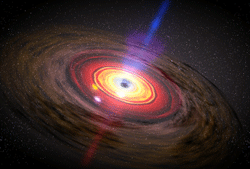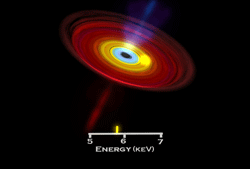Imagine the Universe News - 20 January 2005
A Race Around a Black Hole
| 20 January 2005 |
So you think rockets are fast? Scientists have spotted something going much faster. Like state troopers on a highway, these scientists used a "speed gun" to clock clumps of hot iron gas whipping around a black hole at 20,000 miles per second - over 10 percent of light speed. At that speed, you could get to the moon in about 10 seconds.
Dr. Jane Turner of NASA Goddard Space Flight Center led the observation. She used the XMM-Newton satellite, launched by the European Space Agency. She said that this kind of measurement has never been done before.
For years we have seen only the general commotion caused by massive black holes, that is, a terrific outpouring of light," Dr. Turner said. "We could not track the specifics. Now we can filter through all that light and find patterns that reveal information about black holes never seen before in such clarity."

|
|
This animation shows three hot
blobs of matter orbiting a black hole. (Click on image to view 4.8 MB animation) (Credit: NASA/Dana Berry, Skyworks Digital) (Description) |
This is big news for black hole hunters because the observation marks the first time scientists could trace individual blobs of shredded matter on a complete journey around a black hole. This provides a crucial measurement that has long been missing from black hole studies: an orbital period. Knowing this, scientists can measure black hole mass and other characteristics that have long eluded them.
If this black hole were placed in our Solar System, it would appear like a dark abyss spread out nearly as wide as Mercury's orbit. And the clumps of matter detected would be as far out as Jupiter. The clumps orbit the black hole in a lightning-quick 27 hours (compared to the 12 years it takes Jupiter to orbit the Sun).
But this black hole is far, far away. Dr. Turner's team observed it in a well-known galaxy named Markarian 766, about 170 million light years away in the constellation Coma Berenices (Bernice's Hair). The black hole in Markarian 766 is relatively small although highly active. Its mass is a few million times that of the Sun. Other central black hole systems are over 100 million solar masses.
Matter funnels into this black hole like water swirling down a drain, forming what scientists call an accretion disk. Flares erupt on this disk most likely when magnetic field lines emanating from the central black hole interact with regions on the disk. Zap! These flares are very hot. They glow in X-ray light, which is thousands of times more energetic that the visible light our eyes can detect.

|
|
This animation shows how scientists
track hot material around a black hole via spectral emission lines (Click on image to view 2.5 MB animation. Full Description) (Credit: NASA/Dana Berry, Skyworks Digital) |
Calculating the speeds of the flares and the black hole mass was straightforward, based on Doppler shifting, the technique used by law officers to nab speeders." said Dr. Ian George of NASA Goddard. (Both Drs. Turner and George hold teaching positions at the University of Maryland, Baltimore County.) "Light appears to rise in energy as an object moves toward us and then fall in energy as it moves away. A similar phenomenon happens with the sound of a passing car on a highway, going 'eeeeeeyyoool.'"

|
|
Plot of peak X-ray energy vs time
for three different blobs of matter in the disk around the black
hole in Markarian 766. (Credit: Jane Turner and Lance Miller) |
When the scientists made a graph of energy (on the y-axis) and time (on the x-axis), they saw near-perfect sinusoidal curves from each of the three clumps of matter they observed. Up and down, up and down. The width (or period) of the curves is proportional to black hole mass. The height (or amplitude) of the curves is related to the viewing angle of the accretion disk.
With a known mass and orbital period, the scientists could determine velocity using the relatively simple and traditional physics of Isaac Newton. Scientists do these kinds of measurements in the Solar System all the time. For example, if the Sun were bigger or if the Earth were closer to the Sun, our orbit would be faster because the tug of gravity would be stronger. That is, mass, distance and gravity dictate the speed and shape of orbits. Knowing one set of information helps you determine the other.
Two factors made the black hole measurement possible. The scientists observed particularly persistent flares during a long observation, nearly 27 hours. Also, no telescope before XMM-Newton has had the light-collecting power to allow for a comparison of energy over time. Dr. Turner said this observation confirms a preliminary XMM-Newton result announced by a European team in September - that something as detailed as an orbital period could be detected with the current generation of X-ray telescopes. The combination of results indicates that scientists, given long observation times, are now able to make careful black hole measurements and even test general relativity in the domain of extreme gravity. And moving 20,000 miles per second, these blobs around the black hole are taking scientists on an exciting ride.
